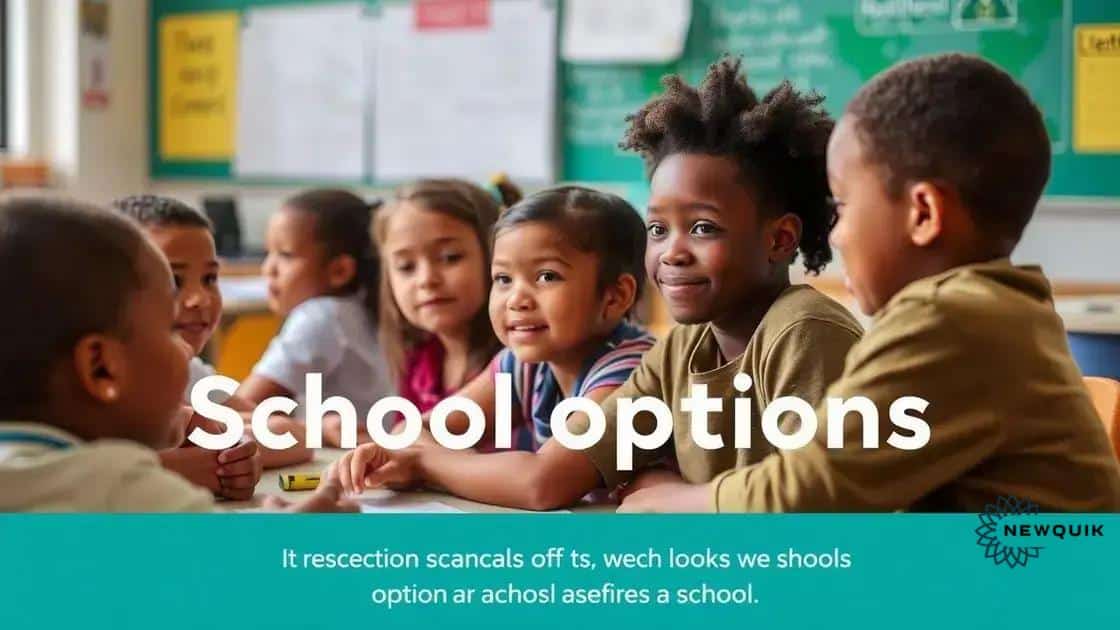School choice policy developments emerge as a game changer

School choice policies allow families to select educational options that best fit their children’s needs, but they also raise concerns about equity, accessibility, and the impact on educational quality.
School choice policy developments emerge as a critical topic in today’s educational landscape. As families seek better opportunities for their children, understanding these policies becomes essential. What options are available, and how do they shape our education system?
Understanding school choice policies
Understanding school choice policies is vital for parents, educators, and policymakers. These policies allow families to select the schools that best fit their children’s needs. With various options available, such as charter schools, magnet schools, and vouchers, it’s important to explore each one.
What are school choice policies?
School choice policies are frameworks that give families the option to choose their children’s schools rather than being restricted to their local district schools. This flexibility aims to improve education quality and empower parents.
Types of school choice
- Charter schools: Publicly funded but operate independently of traditional school systems.
- Magnet schools: Specialized schools that attract students based on their interests and talents.
- Voucher programs: Enable families to use public funds to pay for private school tuition.
- Open enrollment: Allows students to attend schools outside their assigned districts.
Each type offers unique advantages. For example, charter schools often bring innovative teaching methods, while magnet schools may focus on STEM or the arts, attracting diverse talents. Moreover, voucher programs help families afford private education, which can lead to elevated educational standards.
As school choice policies evolve, it’s essential to consider their impact on educational equity. While some argue that these policies enhance options, others raise concerns about potential widening gaps between different socioeconomic groups. How can we ensure that school choice benefits all students? It’s a question that merits thoughtful discussion.
The role of government in school choice
The role of government in school choice is crucial. Governments create the policies that determine how these choices are available to families. They balance the need for educational equity with the desire for parental choice.
Creating policies
Governments establish regulations that govern school choice. These policies can include funding for charter schools, rules for voucher programs, and guidelines for open enrollment. With each decision, they influence how schools compete for students.
Funding and resources
- Public funding: Governments often provide funding for charter schools and voucher programs, making them accessible to families.
- Resource allocation: Governments decide how resources are distributed among traditional public schools and alternative options.
- Accountability standards: Ensuring that all schools, including private and charter, meet specific educational standards is essential for quality assurance.
- Support services: Governments also play a role in offering services and support for families navigating their options.
The decisions made by government officials can impact the availability of school choice and shape the educational landscape. When families have access to various options, they may feel more empowered. However, government must also ensure that these choices do not create imbalances in educational opportunities.
Additionally, discussions about equity and access are central to school choice policies. Governments need to be aware of how policies affect different communities. Are low-income families receiving the same benefits as more affluent ones? This is a significant challenge that requires attention and action.
Effects on educational equity

The effects of school choice on educational equity are significant and complex. While school choice policies aim to provide options for families, they can also create disparities in access to quality education.
Understanding educational equity
Educational equity means that every student, regardless of their background or circumstances, has access to high-quality education. As school choice expands, it’s crucial to examine how it impacts different communities.
Positive impacts
- Increased options: Families have more choices in selecting schools that meet their children’s needs.
- Innovative programs: More schools mean diverse educational programs that can cater to various interests and talents.
- Parental engagement: When parents can choose, they often become more involved in their children’s education.
However, the potential benefits of school choice must be weighed against the challenges it poses for equity. For some families, especially those in low-income areas, access to quality schools may remain limited despite available choices.
Challenges to equity
- Resource allocation: Schools with more funding attract better teachers and resources, widening the gap.
- Accessibility issues: Transportation and information barriers can limit options for disadvantaged families.
- Segregation: School choice can unintentionally lead to social stratification, separating students by race and income.
Addressing these challenges requires careful policy planning. To support educational equity, policymakers must consider how to ensure that all families can benefit from school choice without deepening existing divides. By providing equal access to resources and information, the aim is to create a fairer educational system where every student has the chance to succeed.
Parents’ perspectives on school options
Parents’ perspectives on school options are diverse and deeply influenced by their unique experiences and values. Many parents prioritize finding the best environment for their children, which often drives their interest in various school choices.
Factors influencing choices
Several key factors shape how parents view school options. Location, school reputation, and academic performance are often at the forefront of their decision-making process. Parents want to ensure their children attend schools that offer strong educational foundations.
Communication and support
- Access to information: Many parents express the need for clear information about school programs and what each option entails.
- Community input: Parents often rely on recommendations from friends and family to guide their choices.
- Support services: Availability of counseling and support services can sway parents’ decisions.
- Extracurricular opportunities: Schools that offer sports, arts, and clubs tend to be more attractive to parents.
Despite various options, some parents feel overwhelmed by the choices available. They may question if they are selecting the right path for their children. This feeling is common, as navigating school choice can be daunting.
Community and equity
Many parents also consider the impact of school choice on their communities. They may worry that certain choices lead to disparities in available resources and educational quality. Ensuring that all children, regardless of background, have access to quality education remains a priority for many families.
Ultimately, parents play a vital role in shaping the conversation around school options. Their insights and experiences can guide policies and practices in the education system, pushing for changes that benefit all students.
Future trends in school choice
Future trends in school choice are evolving rapidly as more parents seek alternatives to traditional education. The landscape of education continues to shift, prompting discussions about what lies ahead.
Increased digital learning options
One trend shaping the future is the rise of digital and online learning. With technology improving, more schools are offering virtual classes. This flexibility allows students to learn at their own pace and from the comfort of their own homes.
Personalized education
Another key trend is the focus on personalized education. Schools are beginning to recognize that each student learns differently. Through tailored programs, educators can better meet individual needs.
Growing emphasis on equity
- Equity in access: Policymakers are focusing on ensuring that all families have equal access to quality schools.
- Community engagement: Schools are working to involve communities and parents more in decision-making.
- Inclusive practices: Increased attention is being placed on creating inclusive environments for all students.
As these trends emerge, it is essential to pay attention to how they impact students and families. The concept of school choice will continue to expand, incorporating new ideas and addressing existing challenges.
Policy changes and implications
In the coming years, we may see significant policy shifts that affect school choice. This could include more funding for charter schools, adjustments in how vouchers are distributed, and new regulations that hold all types of schools accountable.
Ultimately, the future of school choice depends on collaboration between parents, educators, and policymakers. Together, they can shape an educational landscape that benefits every child.
FAQ – Frequently Asked Questions about School Choice Policies
What is school choice?
School choice refers to programs that allow parents to select educational options for their children, including charter schools, magnet schools, and private schools.
How can school choice benefit students?
School choice can provide students with access to specialized programs, improve educational quality, and enhance parental involvement in their children’s education.
What are the challenges of school choice?
Challenges include potential inequality in access to quality schools, transportation issues, and the risk of social segregation.
How are policymakers addressing equity in school choice?
Policymakers are focusing on implementing measures that ensure all families have equal access to quality schools and resources.





